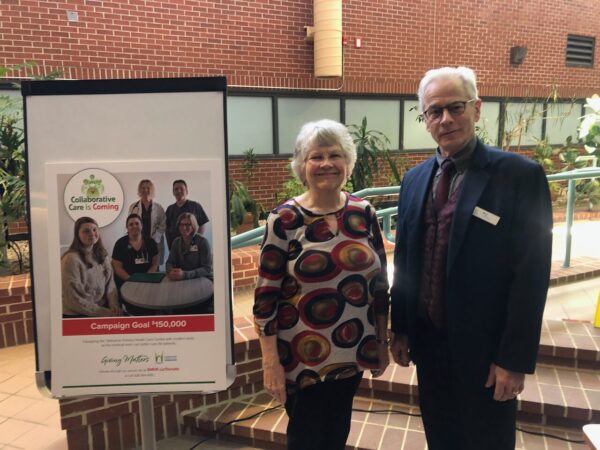
April 8 is going to be a special day in New Brunswick, as a rare total solar eclipse darkens the daytime sky. While Sackville won’t be in the path of 100% totality for the eclipse, residents do have one distinct advantage for observing this astronomical event: Mount Allison’s Gemini Observatory.
CHMA stopped by the observatory last week to meet with associate professor Catherine Lovekin, and find out more about what to expect on April 8.
To call the upcoming eclipse a rare event is an understatement, says Lovekin. “The last total solar eclipse that was visible in New Brunswick was in about 900 AD,” says Lovekin. “It’s been more than 1000 years. So this is a really, really exciting thing.”
While the path of totality stretches across a wide swath of New Brunswick, Sackville sits just outside that path. “We’re going to get about a 99% total eclipse,” says Lovekin, “which means it’s still going to be amazing and really cool to see, but we’re not going to have that period when the moon is completely in front of the sun, and it blocks out enough of the sun’s light that you can see the corona.”
There might also be some obstacles to a clear view of the eclipse, says Lovekin. According to historical weather records, April 8 has been cloudy about 80% of the time in Sackville. “But you shouldn’t despair,” she says. “We’ll still have all of those other effects of it getting dark, the birds might start acting crazy. The last time there was a partial eclipse here at the observatory, we had moths coming out at midday. So we’ll still get that kind of thing.”
Lovekin says the observatory will be open during the eclipse, weather permitting, with both telescopes set up. “We have solar filters that we can use so that you can actually look through the telescope and see the sun,” says Lovekin. ”We’re going to have eclipse glasses available. We’re hoping to set up some of our portable telescopes to project the eclipse, so that you can look at it safely.”
“Safely” is the key word. Normally, humans can rely on basic instinct to avoid damaging their eyes with the sun’s powerful light. But during an eclipse, the partial blocking of that light plays tricks with our basic reactions. “Because the light is blocked,” says Lovekin, “it doesn’t trigger that pain reflex in your eyes, and so you don’t immediately look away. But it’s still bright enough to damage them… Even when it’s 99% covered, it can still damage your eyes.”

There are plenty of ways to safely view what’s happening in the sky during an eclipse. Lovekin recommends checking websites like NASA, the Canadian Space Agency, and Discover the Universe.
“I really want everyone to be able to safely view the eclipse,” says says. “I don’t want anybody to feel like they’re locked inside because they don’t know how to watch it safely. So absolutely, do your research, find eclipse glasses, build a pinhole camera. It’s really easy to find a way to watch the eclipse without damaging your eyes,” including coming to the Gemini Observatory on April 8.
There could be a healthy crowd out for the event, as school children at all Anglophone East District schools will be dismissed early that day. Lovekin says past astronomical events have brought hundreds of people to the observatory.
The path of totality

Unlike lunar eclipses, solar eclipses are region-specific events, says Lovekin, because of the nature of what is happening.
“The moon is passing between us and the sun. And it’s just a coincidence that the moon and the sun have about the same angular size on the sky. And so the moon completely blocks out the sun, if you’re in the right spot,” says Lovekin.
“The moon is big enough to block out the sun, but the sun is so much bigger than it, the moon only casts a small shadow on the earth. And so if you are in that shadow, you see a total eclipse,” she says. As you get farther from the centre of the moon’s shadow, or the path of totality, you see a partial eclipse. “And if you’re not in the path of the shadow at all, you don’t see an eclipse at all,” says Lovekin.
The astronomical coincidence of a total solar eclipse will eventually become impossible, in about 600 million years or so, says Lovekin. “The moon is actually moving away from the Earth at the rate of a couple of centimetres a year,” she explains. “And so right now, we’ve got this coincidence that they’re about the same size in the sky. But in another 600 million years, the moon will have moved further away. And so it won’t be a big enough to block out the sun. We will get partial eclipses and we’ll get annular eclipses when you get a ring, but we will never again get a total eclipse.”
Mount Allison’s department of astronomy hosts regular observations nights, weather depending, at the Gemini Observatory at the corner of Salem and York Streets in Sackville. The next few nights are slated for March 7, March 21, and April 4, from 8:30pm to 10pm. The department posts confirmations or cancellations by 5pm the day of the scheduled observation night, at mta.ca/mago.




















